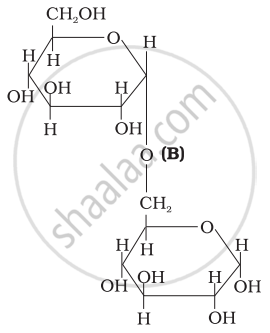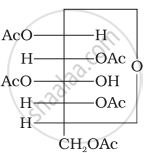Advertisements
Advertisements
प्रश्न
Write the reactions involved when D-glucose is treated with the following reagent:
Br2 water
What happens when D-glucose is treated with the following reagent?
Bromine water
उत्तर
\[\begin{array}{cc}
\phantom{........}\ce{CHO}\phantom{.............}\ce{COOH}\phantom{..}\\
\phantom{.}|\phantom{..................}|\\
\phantom{.......}\ce{(CHOH)4->[Br2 water](CHOH)4}\\
\phantom{.}|\phantom{..................}|\\
\phantom{............}\ce{\underset{\text{D-glucose}}{CH2OH}}\phantom{.........}\ce{\underset{\text{D-gluconic acid}}{CH2OH}}\phantom{.}
\end{array}\]
संबंधित प्रश्न
Write the reaction that indicates the presence of -CHO group in glucose
What do you observe when glucose solution is heated with Tollen’s reagent?
Fill in the blanks by choosing the appropriate word/words from those given in the brackets:
(iodoform, acetaldehyde, positive, greater, acidic, acetone, disaccharide, negative, increases, glucose, decreases, chloroform, polysaccharide, lactose, lesser, basic, cationic hydrolysis, anionic hydrolysis)
Sucrose is a _________ and yields upon hydrolysis, a mixture of ________ and fructose.
What do you observe when glucose is treated with bromine water?
What is the most abundant organic compound on earth?
Glucose does not react with ____________.
Which of the following properties of glucose cannot be explained by its open chain structure?
(i) Glucose does not form hydrogen sulphite with NaHSO3.
(ii) On oxidation with HNO3 glucose gives saccharic acid.
(iii) Glucose is found to exist in two different crystalline forms which are named as α and β.
Glucose is found to exist in two different α and β crystalline forms. These forms can be obtained by:
(i) The α form of glucose is obtained by crystallisation from a concentrated solution of glucose at 303 K.
(ii) The β form of glucose is obtained by crystallisation from a concentrated solution of glucose at 303 K.
(iii) The β form is obtained by crystallisation from hot and saturated aqueous solution at 371 K.
(iv) The α form is obtained by crystallisation from hot and saturated aqueous solution at 371 K.
Which is the least stable form of glucose?
The α-D glucose and β-D glucose differ from each other due to difference in carbon atom with respect to its ____________.
Choose the correct relationship for glucose and fructose:
In the following reaction, identify A and B:
\[\begin{array}{cc}
\ce{C6H12O6 ->[Acetic anhydride] A}\\
\downarrow \text{Conc. nitric acid}\phantom{...}\\
\ce{B}\phantom{.................}\end{array}\]
Three structures are given below in which two glucose units are linked. Which of these linkages between glucose units are between C1 and C4 and which linkages are between C1 and C6?
| (I) |  |
| (II) |  |
| (III) |  |
Why does compound (A) given below not form an oxime?

(A)
How will you distinguish 1° and 2° hydroxyl groups present in glucose? Explain with reactions.
Account for the following:
What happens when D – glucose is treated with the following reagents
Bromine water
Account for the following:
What happens when D – glucose is treated with the following reagents
HNO3
Give the reaction of glucose with hydrogen cyanide. Presence of which group is confirmed by this reaction?
Give a reason for the following observations:
Penta-acetate of glucose does not react with hydroxylamine.
